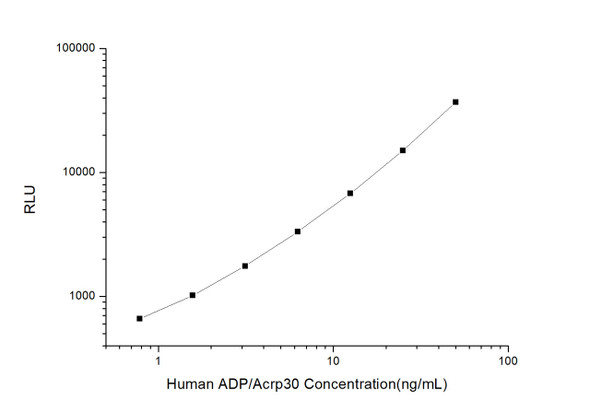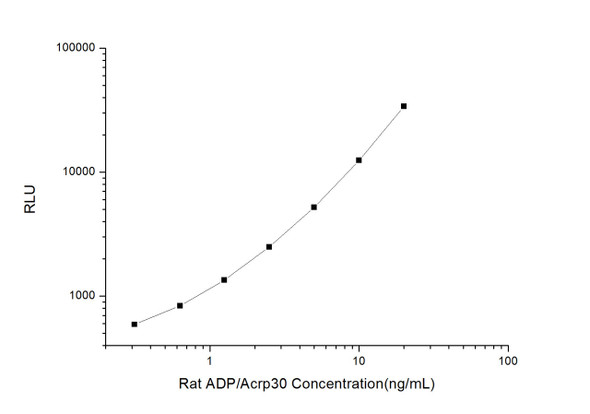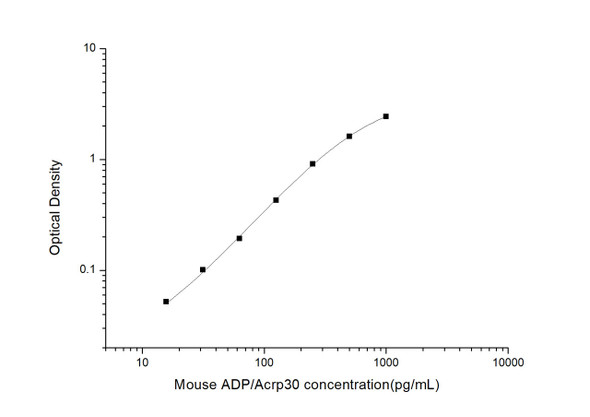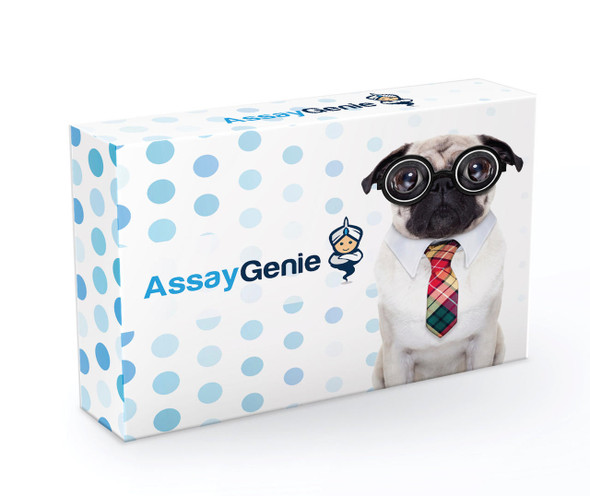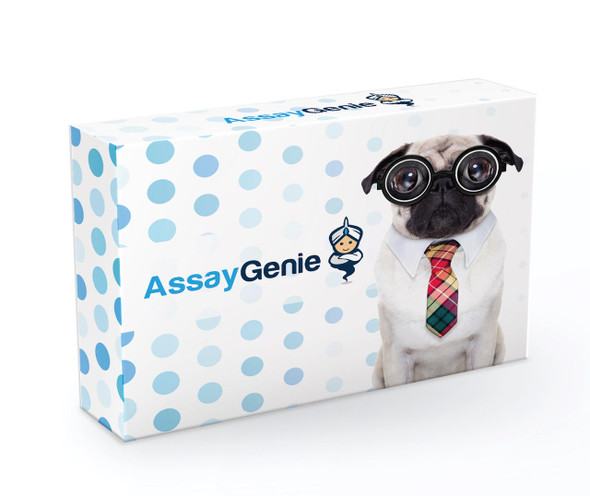Mouse Cell Signalling ELISA Kits 2
Mouse ADP/Acrp30 (Adiponectin) CLIA Kit (MOES00002)
- SKU:
- MOES00002
- Product Type:
- ELISA Kit
- ELISA Type:
- CLIA Kit
- Size:
- 96 Assays
- Sensitivity:
- 0.09ng/mL
- Range:
- 0.16-10ng/mL
- ELISA Type:
- Sandwich
- Synonyms:
- Acrp30, GBP28, ACDC, APM1, ADPN, AdipoQ, ADIPQTL1
- Reactivity:
- Mouse
- Sample Type:
- Serum, plasma and other biological fluids
Description
| Assay type: | Sandwich |
| Format: | 96T |
| Assay time: | 4.5h |
| Reactivity: | Mouse |
| Detection method: | Chemiluminescence |
| Detection range: | 0.16-10 ng/mL |
| Sensitivity: | 0.09 ng/mL |
| Sample volume: | 100µL |
| Sample type: | Serum, plasma and other biological fluids |
| Repeatability: | CV < 15% |
| Specificity: | This kit recognizes Mouse ADP/Acrp30 in samples. No significant cross-reactivity or interference between Mouse ADP/Acrp30 and analogues was observed. |
This kit uses Sandwich-CLIA as the method. The micro CLIA plate provided in this kit has been pre-coated with an antibody specific to Mouse ADP/Acrp30. Standards or samples are added to the appropriate micro CLIA plate wells and combined with the specific antibody. Then a biotinylated detection antibody specific for Mouse ADP/Acrp30 and Avidin-Horseradish Peroxidase (HRP) conjugate are added to each micro plate well successively and incubated. Free components are washed away. The substrate solution is added to each well. Only those wells that contain Mouse ADP/Acrp30, biotinylated detection antibody and Avidin-HRP conjugate will appear fluorescence. The Relative light unit (RLU) value is measured spectrophotometrically by the Chemiluminescence immunoassay analyzer. The RLU value is positively associated with the concentration of Mouse ADP/Acrp30. The concentration of Mouse ADP/Acrp30 in the samples can be calculated by comparing the RLU of the samples to the standard curve.
| UniProt Protein Function: | adiponectin: Important adipokine involved in the control of fat metabolism and insulin sensitivity, with direct anti-diabetic, anti-atherogenic and anti-inflammatory activities. Stimulates AMPK phosphorylation and activation in the liver and the skeletal muscle, enhancing glucose utilization and fatty-acid combustion. Antagonizes TNF-alpha by negatively regulating its expression in various tissues such as liver and macrophages, and also by counteracting its effects. Inhibits endothelial NF-kappa-B signaling through a cAMP-dependent pathway. May play a role in cell growth, angiogenesis and tissue remodeling by binding and sequestering various growth factors with distinct binding affinities, depending on the type of complex, LMW, MMW or HMW. Homomultimer. Forms trimers, hexamers and 12- to 18-mers. The trimers (low molecular weight complexes / LMW) are assembled via non-covalent interactions of the collagen-like domains in a triple helix and hydrophobic interactions within the globular C1q domain. Several trimers can associate to form disulfide-linked hexamers (middle molecular weight complexes / MMW) and larger complexes (higher molecular weight / HMW). The HMW-complex assembly may rely aditionally on lysine hydroxylation and glycosylation. LMW, MMW and HMW complexes bind to HBEGF, MMW and HMW complexes bind to PDGFB, and HMW complex binds to FGF2. Interacts with CTRP9A via the C1q domain (heterotrimeric complex). Synthesized exclusively by adipocytes and secreted into plasma. |
| UniProt Protein Details: | Protein type:Secreted, signal peptide; Endoplasmic reticulum; Hormone; Secreted Cellular Component: extracellular space; cell surface; collagen; protein complex; endoplasmic reticulum; extracellular region Molecular Function:identical protein binding; protein binding; protein homodimerization activity; hormone activity; sialic acid binding; receptor binding Biological Process: negative regulation of MAP kinase activity; negative regulation of phagocytosis; negative regulation of smooth muscle cell proliferation; negative regulation of hormone secretion; positive regulation of cellular protein metabolic process; membrane hyperpolarization; negative regulation of smooth muscle cell migration; glucose homeostasis; negative regulation of granulocyte differentiation; positive regulation of interleukin-8 production; positive regulation of glucose import; negative regulation of gluconeogenesis; response to glucose stimulus; adiponectin-mediated signaling pathway; negative regulation of protein amino acid autophosphorylation; negative regulation of blood pressure; negative regulation of cell migration; protein homooligomerization; positive regulation of I-kappaB kinase/NF-kappaB cascade; negative regulation of heterotypic cell-cell adhesion; positive regulation of signal transduction; glucose metabolic process; negative regulation of tumor necrosis factor production; negative regulation of I-kappaB kinase/NF-kappaB cascade; negative regulation of fat cell differentiation; negative regulation of synaptic transmission; membrane depolarization; positive regulation of peptidyl-tyrosine phosphorylation; positive regulation of fatty acid metabolic process; fatty acid beta-oxidation; negative regulation of macrophage differentiation; cellular response to insulin stimulus; negative regulation of low-density lipoprotein receptor biosynthetic process; positive regulation of protein kinase activity; negative regulation of inflammatory response; brown fat cell differentiation; fatty acid oxidation; positive regulation of protein amino acid phosphorylation; negative regulation of transcription, DNA-dependent; positive regulation of myeloid cell apoptosis; positive regulation of blood pressure |
| UniProt Code: | Q60994 |
| NCBI GenInfo Identifier: | 408359957 |
| NCBI Gene ID: | 11450 |
| NCBI Accession: | Q60994. 2 |
| UniProt Secondary Accession: | Q60994,Q62400, Q6GTX4, Q9DC68, |
| UniProt Related Accession: | Q60994 |
| Molecular Weight: | 26,809 Da |
| NCBI Full Name: | Adiponectin |
| NCBI Synonym Full Names: | adiponectin, C1Q and collagen domain containing |
| NCBI Official Symbol: | Adipoq |
| NCBI Official Synonym Symbols: | APN; Acdc; apM1; 30kDa; GBP28; adipo; Acrp30 |
| NCBI Protein Information: | adiponectin; adipocyte-specific protein AdipoQ; adipocyte complement related protein; 30 kDa adipocyte complement-related protein; adipocyte complement-related 30 kDa protein; adipocyte, C1Q and collagen domain containing; adipocyte, C1q and collagen domain-containing protein |
| UniProt Protein Name: | Adiponectin |
| UniProt Synonym Protein Names: | 30 kDa adipocyte complement-related protein; Adipocyte complement-related 30 kDa protein; ACRP30; Adipocyte, C1q and collagen domain-containing protein; Adipocyte-specific protein AdipoQ |
| Protein Family: | Adiponectin |
| UniProt Gene Name: | Adipoq |
| UniProt Entry Name: | ADIPO_MOUSE |
As the RLU values of the standard curve may vary according to the conditions of the actual assay performance (e. g. operator, pipetting technique, washing technique or temperature effects), the operator should establish a standard curve for each test. Typical standard curve and data is provided below for reference only.
| Concentration (ng/mL) | RLU | Average | Corrected |
| 10 | 32234 32708 | 32471 | 32447 |
| 5 | 15316 15624 | 15470 | 15446 |
| 2.5 | 8132 6874 | 7503 | 7479 |
| 1.25 | 3607 3699 | 3653 | 3629 |
| 0.63 | 1862 1660 | 1761 | 1737 |
| 0.31 | 884 764 | 824 | 800 |
| 0.16 | 340 374 | 357 | 333 |
| 0 | 24 24 | 24 | -- |
Precision
Intra-assay Precision (Precision within an assay): 3 samples with low, mid range and high level Mouse ADP/Acrp30 were tested 20 times on one plate, respectively.
Inter-assay Precision (Precision between assays): 3 samples with low, mid range and high level Mouse ADP/Acrp30 were tested on 3 different plates, 20 replicates in each plate.
| Intra-assay Precision | Inter-assay Precision | |||||
| Sample | 1 | 2 | 3 | 1 | 2 | 3 |
| n | 20 | 20 | 20 | 20 | 20 | 20 |
| Mean (ng/mL) | 0.48 | 0.98 | 5.00 | 0.51 | 1.06 | 4.84 |
| Standard deviation | 0.04 | 0.08 | 0.57 | 0.06 | 0.12 | 0.48 |
| C V (%) | 8.33 | 8.16 | 11.40 | 11.76 | 11.32 | 9.92 |
Recovery
The recovery of Mouse ADP/Acrp30 spiked at three different levels in samples throughout the range of the assay was evaluated in various matrices.
| Sample Type | Range (%) | Average Recovery (%) |
| Serum (n=5) | 91-102 | 96 |
| EDTA plasma (n=5) | 93-109 | 100 |
| Cell culture media (n=5) | 89-103 | 95 |
Linearity
Samples were spiked with high concentrations of Mouse ADP/Acrp30 and diluted with Reference Standard & Sample Diluent to produce samples with values within the range of the assay.
| Serum (n=5) | EDTA plasma (n=5) | Cell culture media (n=5) | ||
| 1:2 | Range (%) | 89-105 | 89-104 | 94-111 |
| Average (%) | 96 | 97 | 101 | |
| 1:4 | Range (%) | 95-111 | 88-103 | 88-101 |
| Average (%) | 101 | 95 | 94 | |
| 1:8 | Range (%) | 84-98 | 99-116 | 91-103 |
| Average (%) | 91 | 106 | 96 | |
| 1:16 | Range (%) | 102-116 | 87-99 | 103-117 |
| Average (%) | 109 | 93 | 109 |
An unopened kit can be stored at 4°C for 1 month. If the kit is not used within 1 month, store the items separately according to the following conditions once the kit is received.
| Item | Specifications | Storage |
| Micro CLIA Plate(Dismountable) | 8 wells ×12 strips | -20°C, 6 months |
| Reference Standard | 2 vials | |
| Concentrated Biotinylated Detection Ab (100×) | 1 vial, 120 µL | |
| Concentrated HRP Conjugate (100×) | 1 vial, 120 µL | -20°C(shading light), 6 months |
| Reference Standard & Sample Diluent | 1 vial, 20 mL | 4°C, 6 months |
| Biotinylated Detection Ab Diluent | 1 vial, 14 mL | |
| HRP Conjugate Diluent | 1 vial, 14 mL | |
| Concentrated Wash Buffer (25×) | 1 vial, 30 mL | |
| Substrate Reagent A | 1 vial, 5 mL | 4°C (shading light) |
| Substrate Reagent B | 1 vial, 5 mL | 4°C (shading light) |
| Plate Sealer | 5 pieces | |
| Product Description | 1 copy | |
| Certificate of Analysis | 1 copy |
- Set standard, test sample and control (zero) wells on the pre-coated plate and record theirpositions. It is recommended to measure each standard and sample in duplicate. Note: addall solutions to the bottom of the plate wells while avoiding contact with the well walls. Ensuresolutions do not foam when adding to the wells.
- Aliquot 100 µL of standard solutions into the standard wells.
- Add 100 µL of Sample / Standard dilution buffer into the control (zero) well.
- Add 100 µL of properly diluted sample (serum, plasma, tissue homogenates and otherbiological fluids. ) into test sample wells.
- Cover the plate with the sealer provided in the kit and incubate for 90 min at 37 °C.
- Aspirate the liquid from each well, do not wash. Immediately add 100 µL of BiotinylatedDetection Ab working solution to each well. Cover the plate with a plate seal and gently mix. Incubate for 1 hour at 37 °C.
- Aspirate or decant the solution from the plate and add 350 µL of wash buffer to each welland incubate for 1-2 minutes at room temperature. Aspirate the solution from each well andclap the plate on absorbent filter paper to dry. Repeat this process 3 times. Note: a microplatewasher can be used in this step and other wash steps.
- Add 100 µL of HRP Conjugate working solution to each well. Cover with a plate seal andincubate for 30 min at 37 °C.
- Aspirate or decant the solution from each well. Repeat the wash process for five times asconducted in step 7.
- Add 100 µL of Substrate mixture solution to each well. Cover with a new plate seal andincubate for no more than 5 min at 37 °C. Protect the plate from light.
- Determine the RLU value of each well immediately.


